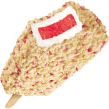They all scream...

|

|
As temperatures rose above 90 degrees Wednesday, summertime undergrads flocked to the ice-cream truck dispensing free Good Humor bars at the edge of Hutch Courtyard just before noon. Under the shade of trees, and fanned by an occasional light breeze, the clump of students waiting for ice cream moved along briskly. After grabbing a chocolate éclair, strawberry shortcake, candy center crunch, toasted almond, or sundae bar, several students clustered in small groups, chatting.
By 12:25 supplies ran out. As Pars Ice Cream employee Roxanne started up the truck, someone called, “Are you coming back?” “In two weeks!” she replied, already on the move.
The free treats came courtesy of the Office of the Reynolds Club and Student Activities (ORCSA), CAPS, and the Alumni Association, whose Noontime Noise programs, featuring live music and free ice cream, are a part of Summer in the City, a series of events for students on campus this summer. Wednesday’s DJ, according to Katy Bologna, a rising second-year and ORCSA’s summer assistant programmer, left his records at home. By the time he returned to the DJ booth at 12:45, the event was over.
“Next time, I promise, there will be music right at 12,” Bologna said. “The DJ messing up is a one-time thing.” Most of the spectators seemed satisfied enough with the ice cream. As Maria Patterson, a rising third-year staying on campus to work in a physics lab, said, “I give it two thumbs up because I like free ice cream.”
Hana Yoo, '07

















